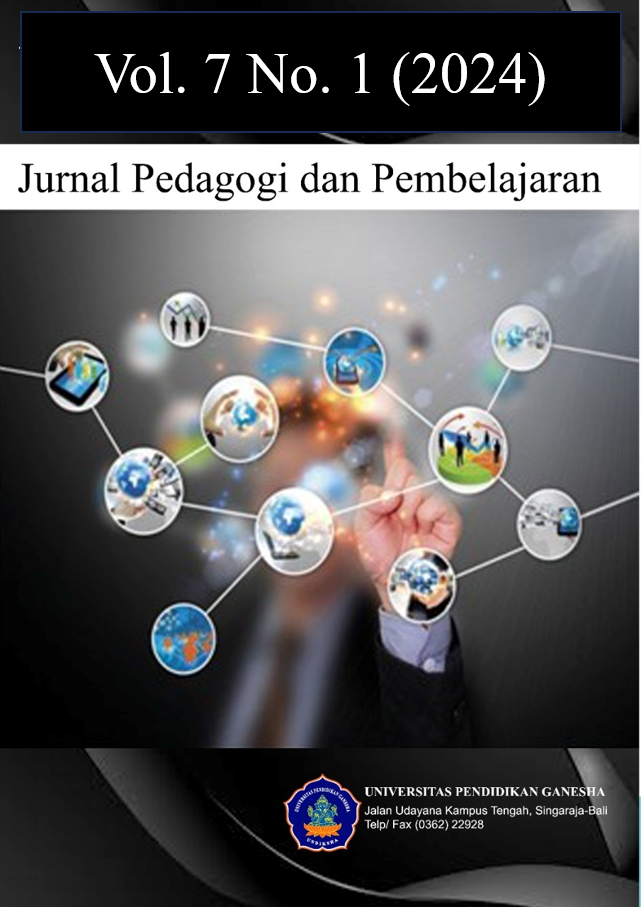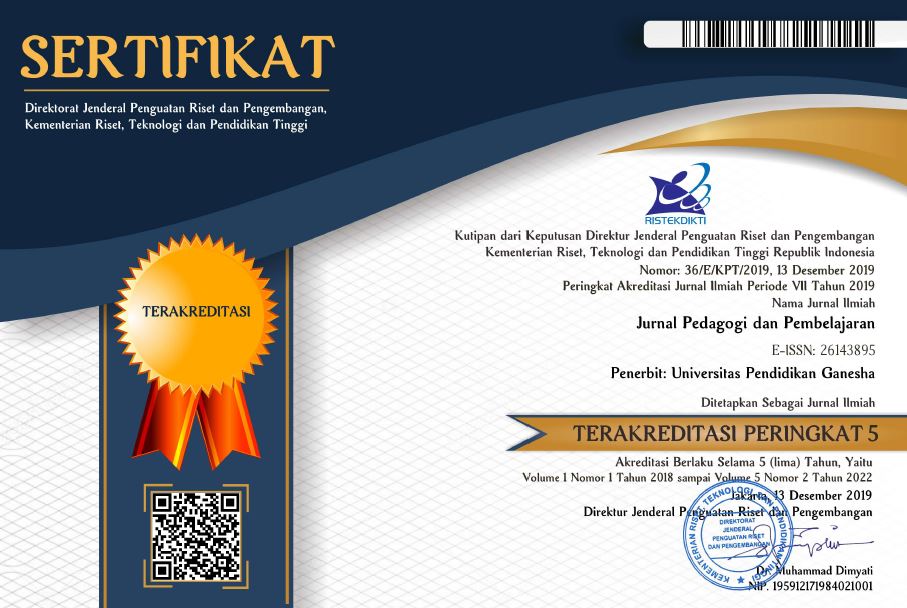Implementation of the Pteridophyta Smart Card to Increase Students' Understanding of Fern Material
DOI:
https://doi.org/10.23887/jp2.v7i1.67511Kata Kunci:
Learning media, Ferns, Pteridophyta Smart CardAbstrak
Ferns (Pteridophyta) are one of the materials that must be studied by biology and biology education students. However, based on previous research, many students still have difficulty recognizing or identifying ferns. This condition is caused by learning which is still carried out conventionally, relying on textbooks with minimal pictures or photos and is not in accordance with the characteristics or learning styles of current Generation Z students. Therefore, the aim of this research is to analyze the effectiveness and attractiveness of the Pteridophyta Smart Card as a learning medium to improve learning outcomes. This type of research is quantitative research using a One-Group Pretest-Posttest design with the research subjects being 20 4th semester students of the biology education study program who were selected using purposive sampling. Data collection was carried out using pretest and posttest, questionnaires and observations. The data was analyzed using an effectiveness test which was analyzed using the gain score formula, and an attractiveness test which was analyzed using a user validation calculation formula. The results of this research reveal that the Pteridophyta Smart Card media is effectively used as a learning medium for students with an attractiveness level of up to 91.25%, which means it can be concluded that the Pteridophyta Smart Card media is very attractive for students because it suits the characteristics or learning styles of Generation Z students. , so that it can improve students' learning outcomes. This research provides theoretical and practical implications in terms of improving students' learning outcomes using Pteridophyta Smart Card media.
Referensi
Abrori, FM (2020). Plant Blindness Also Attacks Biology Education Students: Case Study of Pre-Lecture and Post-Lecture Plant Taxonomy. Biopedagogia, 2(2), 138–144. https://doi.org/10.35334/biopedagogia.v2i2.1843. DOI: https://doi.org/10.35334/biopedagogia.v2i2.1843
Adriyanto, AR, Santosa, I., & Syarief, A. (2019). Understanding Generation Z Behavior as a Basis for Developing Online Learning Materials. Proceedings: Art, Technology, And Society, 165–173
Anisa. (2022). Study of Ferns (Pteridophyta) in the Beungga Waterfall Area as a Reference for the Taxonomy Course of Lower Plants [Ar-Raniry State Islamic University]. https://repository.ar-raniry.ac.id/id/eprint/24173/1/Anisa, 160207074, FTK, PBL, 085270821624.pdf.
Aswin, P., Muhdhar, MHI Al, & Saptasari, M. (2018). Study of Problems in the Plant Taxonomy Course as a Foundation for Learning Development in the Biology Study Program. Journal of Education: Theory, Research, and Development, 3(11), 1440—1445. http://download.garuda.kemdikbud.go.id/article.php?article=921936&val=9626&.
Azzahra, D., Arfan, R., Moeis, I., Indrawadi, J., & Dharma, S. (2023). Pancasila And Citizenship Education E-Module Teaching Materials Using Google Classroom for Improving the Quality of Learning. Journal of Pedagogy and Learning, 6(1), 64–72. https://doi.org/10.23887/jp2.v6i1.56048. DOI: https://doi.org/10.23887/jp2.v6i1.56048
Bunardi, AF, & Prestianta, AM (2023). The Relationship between Media Literacy and Information Processing Ability in 360-degree Video. Communicator, 15(1), 19–30. https://doi.org/10.18196/jkm.18182. DOI: https://doi.org/10.18196/jkm.18182
Efendi, W. W, & Iswahyudi, S. (2019). Diversity of Ferns in East Java. Science House.
Efendi, Wawan Wahyudi, Atiqoh, & Karyono, H. (2023). Development of Pteridophyta Smart Cards as a Learning Media for Ferns to Reduce Plant Blindness among Students. BIO-EDU: Journal Of Biological Education, 8(1), 59–69. https://doi.org/10.32938/jbe.v8i1.4407. DOI: https://doi.org/10.32938/jbe.v8i1.4407
Efrialda, PP, & Subiantoro, AW (2022). Development of an E-Module for the Body Defense System Using Instagram to Improve the Argumentation Skills of Class XI High School Students. Journal of Biology Education, 13(1), 41–51. https://doi.org/10.17977/um052v13i1p41-51. DOI: https://doi.org/10.17977/um052v13i1p41-51
Fajri, Z. (2020). Development of Thematic Worksheets Based on Contextual Teaching and Learning (CTL) Sub Theme My Family Members for Grade 1 Elementary School Students. TEACHER: Journal of Basic Education, 4(1), 15–21. http://risbang.unuja.ac.id/media/arsip/berkas_penelitian/83_KWrb64G.pdf.
Fitriani, L., & Wardianti, Y. (2014). Analysis of Students' Ability to Identify Ferns (Pterdophyta). Journal of Educational Perspectives, 8(2), 143–151. https://ojs.stkippgri-lubuklinggau.ac.id/index.php/JPP/article/view/443.
Hasan, M., Milawati, Darodjat, Harahap, TK, Tahrim, T., Anwari, AM, Rahmat, A., Masdiana, & Indra, IM (2021). Instructional Media. Media Throne.
Hastini, LY, Fahmi, R., & Lukito, H. (2020). Can Learning Using Technology Increase Human Literacy in Generation Z in Indonesia? JAMIKA: Journal of Information Management, 10(1), 12–28. https://doi.org/10.34010/jamika.v10i1.2678. DOI: https://doi.org/10.34010/jamika.v10i1.2678
Illahaqi, AAD, & Aloysius, S. (2019). Fern Diversity in Mount Merapi National Park and Its Potential as a Biology Learning Resource. Journal of Physics: Conference Series, 1241(1), 1–8. https://doi.org/10.1088/1742-6596/1241/1/012017. DOI: https://doi.org/10.1088/1742-6596/1241/1/012017
Karina, M., Bila, NS, Primantari, R., Tara, JD, Rahmawati, AF, Murti, NW, Qintara, MA, Hanifah, F., Wahyuni, D., Anzirah, AA, & Novita, MV (2021 ). Gen Z Insights: Perspectives on Education. UNISRI Press.
Laksono, RKS, Nurcahyo, H., & Wibowo, Y. (2023). Application of Socio-scientific Issues Based e-books in Increasing Learning Independence on Blood Circulation System Material. JINoP (Journal of Learning Innovation), 9(1), 58–69. https://doi.org/10.22219/jinop.v9i1.22843. DOI: https://doi.org/10.22219/jinop.v9i1.22843
Mawaddah, W., Ahied, M., Hadi, WP, & Wulandari, AYR (2019). Feasibility Test of Powerpoint-Based Interactive Multimedia Accompanied by the Jeopardy Game on Student Learning Motivation. Natural Science Education Research, 2(2), 174–185. https://doi.org/10.21107/nser.v2i2.6254. DOI: https://doi.org/10.21107/nser.v2i2.6254
Muniandy, B. K., Ping, P. F., & Rai, R. P. M. (2023). The Effective Learning Process In 5E Flipped Learning Environment: A Case Study Of Medical Assistant Students. JPBI (Indonesian Journal of Biology Education), 9(2), 134–144. https://doi.org/10.22219/jpbi.v9i2.26269. DOI: https://doi.org/10.22219/jpbi.v9i2.26269
Muswita, Yelianti, U., Intan, A., & Kusuma, L. (2020). Development of a Booklet on Ferns in the Sultan Thaha Syaifuddin Forest Park as Enrichment Material for Plant Taxonomy Courses. Biodik: Scientific Journal of Biology Education, 6(1), 58–75. https://doi.org/10.22437/bio.v6i1.8642. DOI: https://doi.org/10.22437/bio.v6i1.8642
Muswita, Yelianti, U., & Murni, P. (2021). Effectiveness of Booklet Media on Knowledge of Fern Plant Types in Biology Education Study Program Students. BIODIK: Scientific Journal of Biology Education, 7(2), 23–32. https://doi.org/10.22437/bio.v7i2.12328. DOI: https://doi.org/10.22437/bio.v7i2.12328
Nawawi, MI (2020). The Influence of Learning Media on Learning Motivation: A Review based on Generation Z Characters. Journal of Educational Research and Studies: E-Saintika, 4(2), 197–210. https://doi.org/10.36312/e-saintika.v4i2.216. DOI: https://doi.org/10.36312/e-saintika.v4i2.216
Nitta, J. H., Schuettpelz, E., Ramírez-Barahona, S., & Iwasaki, W. (2022). An Open and Continuously Updated Fern Tree of Life. Frontiers in Plant Science, 1–17. https://doi.org/10.3389/fpls.2022.909768. DOI: https://doi.org/10.1101/2022.03.31.486640
Nurlita, Arifin, YF, & Winarti, A. (2021). The Practicality of Popular Scientific Book of Pteridophytes Diversity in Tabanio Beach Forest, Tanah Laut District, South Borneo. BIO-INOVED : Journal of Biology-Educational Innovation, 3(2), 108–112 . https://doi.org/10.20527/bino.v3i2.10294. DOI: https://doi.org/10.20527/bino.v3i2.10294
Parmini, GAN, Suarni, NK, & Renda, NT (2022). Effective Learning Through E-Modules Topics Properties of Objects and Changes in the Form of Objects. Journal of Pedagogy and Learning, 5(3), 403–411. https://doi.org/10.23887/jp2.v5i3.49500. DOI: https://doi.org/10.23887/jp2.v5i3.49500
Parsley, K. M. (2020). Plant Awareness Disparity: A Case For Renaming Plant Blindness. Plants People Planet, 2(6), 581–687. https://doi.org/10.1002/ppp3.10153. DOI: https://doi.org/10.1002/ppp3.10153
Prahani, BK, Jatmiko, B., Hariadi, B., Sunarto, D., Sagiran, T., Amelia, T., & Lemantara, J. (2020). Blended Web Mobile Learning (BWML) Model to Improve Students' Higher Order Thinking Skills. IJET: International Journal of Emerging Technologies in Learning, 15(11), 42–55. https://doi.org/10.3991/ijet.v15i11.12853. DOI: https://doi.org/10.3991/ijet.v15i11.12853
Prasani, A., Puspita, L., & Putra, EP (2021). Ferns (Pteridophyta) in the Fatmawati Sukarno Bengkulu State Islamic University Campus Area. BIOSYLAMPARI JOURNAL: Journal of Biology, 4(1), 7–12. https://doi.org/10.31540/biosilampari.v4i1.1347. DOI: https://doi.org/10.31540/biosilampari.v4i1.1347
Renita, A., Setyowati, E., Fauziah, A., & Purwanto, N. (2020). Development of an Encyclopedia of Ferns as a Biodiversity Learning Resource. Journal of Biology and Its Learning, 7(1), 1–6. https://doi.org/10.29407/jbp.v7i1.14797. DOI: https://doi.org/10.29407/jbp.v7i1.14797
Ridhana, A., Winarti, A., & Badruzsaufari. (2021). Effectiveness of Popular Scientific Book "Pteridophyta in Loksado Area" to Improve Students Critical Thinking Skills. BIO-INOVED : Journal of Biology-Educational Innovation, 3(1), 6–11 .https://doi.org/10.20527/bino.v3i1.9909. DOI: https://doi.org/10.20527/bino.v3i1.9909
Shatto, B., & Erwin, K. (2016). Moving on From Millennials: Preparing for Generation Z. The Journal of Continuing Education in Nursing, 47(6), 253–254. https://doi.org/10.3928/00220124-20160518-05. DOI: https://doi.org/10.3928/00220124-20160518-05
Siregar, SH (2021). Development of a Field Guide Book on the Pteridophyta Topic in Padang Lawas Regency. Journal of Physics: Conference Series, 1819(012063), 1–8. https://doi.org/10.1088/1742-6596/1819/1/012063. DOI: https://doi.org/10.1088/1742-6596/1819/1/012063
Susilaswati, Y., & Sugandi, KM (2018). Student's Skills on Identifying Plants at Majalengka University Environment as Competency of Plant Morphology Subjects. Bioeduciana, 3(1), 29–37. http://jurnal.unsil.ac.id/index.php/bioed/index.
Sutrisno, Kamid, Kurniawan, DA, Anwar, K., Triani, E., & Septi, SE (2023). ZPD Technological Learning Environment In Learning Computational Thinking Skill-Based Mathematics. Journal of Pedagogy and Learning, 6(1), 73–81. https://doi.org/10.23887/jp2.v6i1.57920. DOI: https://doi.org/10.23887/jp2.v6i1.57920
Syahriani, & Sofyan. (2020). Development of Pteridophyta Comic-Based Teaching Materials for Biology Education Students at UINAlauddin Makassar. BIODIK: Scientific Journal of Biology Education, 6(2), 118–132 . https://doi.org/10.22437/bio.v6i2.8855. DOI: https://doi.org/10.22437/bio.v6i2.8855
Vizcaya-Moreno, M. F., & Pérez-Cañaveras, R. M. (2020). Social Media Used and Teaching Methods Preferred by Generation Z Students in the Nursing Clinical Learning Environment: A Cross-Sectional Research Study. International Journal of Environmental Research and Public Health, 17(8267), 1–10. https://doi.org/10.3390/ijerph17218267. DOI: https://doi.org/10.3390/ijerph17218267
Widyatmoko, D. (2018). Indonesian Plant Conservation Innovations and Strategies to Reduce the Rate of Extinction. LIPI Press.
Yuskianti, V., Rahayu, SKD, & Handayani, T. (2018). Diversity of Terrestrial Ferns in Special Purpose Forest Areas (KHDTK) Kaliurang Yogyakarta. BIOEDUCATION: Journal of Biology Education, 11(2), 85–92 . https://doi.org/10.20961/bioedukasi-uns.v11i2.22922.
Unduhan
Diterbitkan
Cara Mengutip
Terbitan
Bagian
Lisensi
Hak Cipta (c) 2023 Atiqoh, Wawan Wahyudi Efendi, Wahyu Prihanta

Artikel ini berlisensiCreative Commons Attribution-ShareAlike 4.0 International License.
Authors who publish with Jurnal Pedagogi dan Pembelajaran agree to the following terms:- Authors retain copyright and grant the journal the right of first publication with the work simultaneously licensed under a Creative Commons Attribution License (CC BY-SA 4.0) that allows others to share the work with an acknowledgment of the work's authorship and initial publication in this journal
- Authors are able to enter into separate, additional contractual arrangements for the non-exclusive distribution of the journal's published version of the work (e.g., post it to an institutional repository or publish it in a book), with an acknowledgment of its initial publication in this journal.
- Authors are permitted and encouraged to post their work online (e.g., in institutional repositories or on their website) prior to and during the submission process, as it can lead to productive exchanges, as well as earlier and greater citation of published work. (See The Effect of Open Access)










